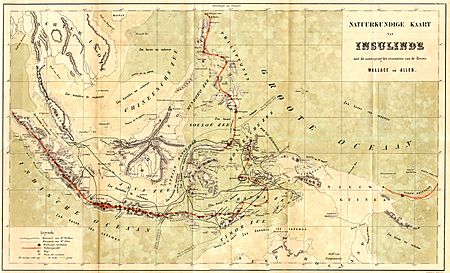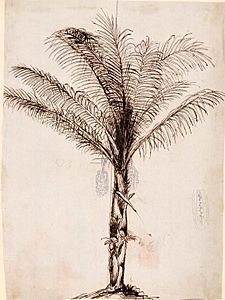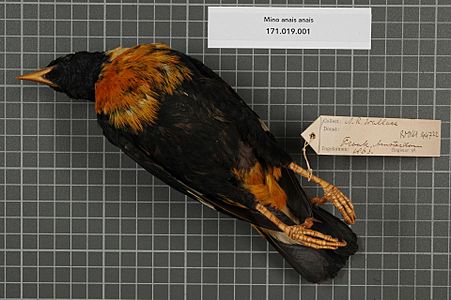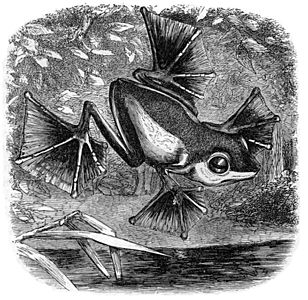Alfred Russel Wallace facts for kids
Quick facts for kids
Alfred Russel Wallace
|
|
|---|---|
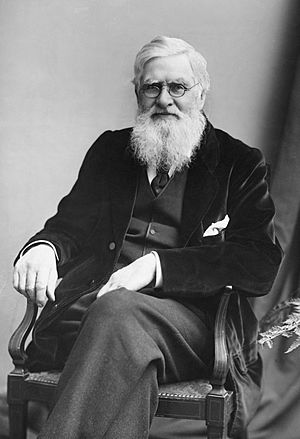
Wallace in 1895
|
|
| Born | 8 January 1823 Llanbadoc, Monmouthshire, Wales
|
| Died | 7 November 1913 (aged 90) Broadstone, Dorset, England
|
| Known for |
|
| Spouse(s) | Annie Mitten (m. 1866) |
| Children | Herbert, Violet, William |
| Awards |
|
| Scientific career | |
| Fields |
|
| Author abbrev. (botany) | Wallace |
Alfred Russel Wallace (8 January 1823 – 7 November 1913) was a British naturalist, explorer, and scientist. He is famous for developing the theory of evolution through natural selection at the same time as Charles Darwin.
Wallace was a great adventurer. He spent years exploring the jungles of the Amazon River basin in South America and then the Malay Archipelago in Asia. During his travels, he collected over 125,000 animal specimens, including thousands of species that were new to science.
His studies of where different animals lived led him to become known as the "father of biogeography". He discovered a famous boundary line, now called the Wallace Line, that separates the animals of Asia from those of Australia.
In 1858, he sent his ideas about evolution to Charles Darwin. This pushed Darwin to publish his own work, and their ideas were presented together. Wallace became one of the most important thinkers on evolution in the 1800s. He was also one of the first scientists to warn about the negative effects of human activity on the environment.
Contents
Biography
Early Life and First Adventures
Alfred Russel Wallace was born in Wales in 1823. His family did not have a lot of money, so he left school at age 14. He began working with his brother as a surveyor, which involved measuring land. This work took him all over the countryside of England and Wales, where he developed a love for nature and began collecting plants.
In his free time, Wallace read many books about science and exploration. He met another young insect collector named Henry Bates. Inspired by stories of explorers like Charles Darwin, Wallace and Bates decided to travel to the Amazon rainforest in Brazil. They planned to pay for their trip by collecting animal specimens and selling them to museums and collectors back home.
For four years, Wallace explored the Amazon, collecting thousands of insects, birds, and other animals. He made detailed maps and notes about the people, animals, and plants he saw.
Tragically, on his way back to Britain in 1852, his ship caught fire and sank. Wallace lost almost all of his specimens and notes from the trip. He and the crew survived for ten days in an open boat before being rescued. Despite this disaster, he was not discouraged from exploring.
The Malay Archipelago
From 1854 to 1862, Wallace travelled through the Malay Archipelago (now Malaysia and Indonesia). This trip was even more successful than his Amazon adventure. He travelled over 14,000 miles and visited dozens of islands, often in small, simple boats.
He and his assistants, especially a skilled collector named Ali, gathered an amazing 125,660 specimens. These included over 83,000 beetles. He discovered thousands of new species, including the gliding tree frog now called Wallace's flying frog.
It was during these travels that Wallace made his most important discoveries. He noticed major differences in the types of animals found on different islands, even when they were close to each other. This led to his famous discovery of the Wallace Line.
In 1869, he published a book about his adventures called The Malay Archipelago. It became very popular and is still considered one of the best books about scientific exploration ever written.
|
Return to Britain
Wallace returned to Britain in 1862 as a well-known scientist. He became friends with Charles Darwin and other important thinkers. In 1866, he married Annie Mitten, and they had three children.
Even though he was famous, Wallace struggled with money for much of his life. He lost money in bad investments and had to work grading exams and writing articles to support his family. Darwin knew about his friend's problems and helped convince the government to give Wallace a small pension for his contributions to science.
The Theory of Evolution
A Big Idea in a Fever
While exploring the islands of the Malay Archipelago, Wallace spent a lot of time thinking about how species change over time. He had already published a paper in 1855, known as the "Sarawak Law," which stated that new species always appear near a similar, closely related species.
In 1858, while sick with a fever on the island of Gilolo, he had a sudden idea. He remembered reading about how things like disease and hunger keep human populations from growing too large. He realized the same thing must happen to animals.
He asked himself, why do some animals die while others live? The answer, he thought, was that the ones who were "best fitted" to their environment survived. These survivors would pass their useful traits to their offspring. Over a long time, this process could create a completely new species. He had discovered the theory of natural selection.
A Letter to Darwin
Excited, Wallace immediately wrote down his ideas in an essay. He sent it to the one person he knew was interested in the topic: Charles Darwin. He asked Darwin to review it and show it to the geologist Charles Lyell.
Darwin was shocked when he read the essay. He had been working on the exact same theory for 20 years but had never published it. He wrote to Lyell, "he could not have made a better short abstract! Even his terms now stand as heads of my chapters."
To be fair to both men, Lyell and another scientist, Joseph Hooker, decided to present Wallace's essay and some of Darwin's unpublished writings at a scientific meeting in London on July 1, 1858.
Wallace was still on the other side of the world and knew nothing about this until later. He was happy just to be included and never felt bitter. The joint publication pushed Darwin to finally write his famous book, On the Origin of Species, which was published the next year. Wallace and Darwin remained good friends for the rest of their lives.
The Wallace Line
One of Wallace's most famous discoveries is the Wallace Line. While travelling, he noticed that the animals on the islands of Bali and Lombok were completely different, even though the islands were separated by only a narrow strait of water.
On Bali and other islands to the west, the animals were like those in Asia (monkeys, tigers, woodpeckers). But on Lombok and islands to the east, the animals were like those in Australia (marsupials like the cuscus, and cockatoos).
He realized he had found a major dividing line in the animal world. This boundary exists because the western islands were once connected to Asia, while the eastern islands were connected to Australia. This work helped create the science of biogeography, the study of why plants and animals live where they do.
A Man of Many Interests
Protecting the Environment
Because he had seen so much of the natural world, Wallace understood the impact of human activity on the environment. As early as 1878, he wrote about the dangers of deforestation (cutting down forests) and soil erosion.
He warned that clearing rainforests in places like Sri Lanka and India would damage the climate and ruin the land. He saw how goats introduced to the island of Saint Helena had destroyed the forests, turning a green island into barren rock. He was one of the first scientists to speak out about protecting the natural world.
Life on Other Planets
Wallace was also interested in the possibility of life on other planets. In his 1904 book Man's Place in the Universe, he was one of the first biologists to seriously study the topic. He concluded that Earth was probably the only planet in our solar system that could support life.
He later wrote a book called Is Mars Habitable? in 1907. In it, he argued against the popular idea that there were canals on Mars built by intelligent beings. He used scientific evidence to show that the conditions on Mars were too cold and the atmosphere too thin for liquid water or life to exist.
Legacy
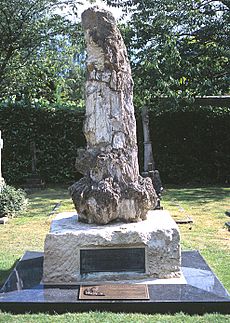
Wallace died on November 7, 1913, at the age of 90. At the time, he was one of the most famous scientists in the world. However, for many years after his death, his name was largely forgotten, and Darwin alone was given credit for the theory of evolution.
This happened partly because Darwin's book On the Origin of Species was so influential. Also, Wallace had some unconventional beliefs, such as an interest in spiritualism (the belief in communication with spirits), which made some scientists uncomfortable.
In recent years, however, there has been a renewed interest in Alfred Russel Wallace. Historians now recognize his huge contributions to science. He is remembered not only as the co-discoverer of natural selection but also as a great explorer, a brilliant naturalist, and a pioneer of environmentalism. In 2013, on the 100th anniversary of his death, a statue of Wallace was unveiled at the Natural History Museum in London to honour his legacy.
See Also
 In Spanish: Alfred Russel Wallace para niños
In Spanish: Alfred Russel Wallace para niños


